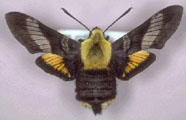Native Plants
Search for native plants by scientific name, common name or family. If you are not sure what you are looking for, try the Combination Search or our Recommended Species lists.
Rubus parviflorus
Rubus parviflorus Nutt.
Western Thimbleberry, Thimbleberry
Rosaceae (Rose Family)
Synonym(s):
USDA Symbol: rupa
USDA Native Status: L48 (N), AK (N), CAN (N)
Western thimble-berry is an erect, unarmed, shrub, 1 1/2-5 ft. tall with gray, flaking bark; strong, flexible stems; large, shiny, maple-like, deciduous leaves; terminal clusters of white (sometimes pink-tinged) flowers; and red, raspberry-like fruit. Erect, unarmed shrub with palmately lobed leaves and raspberrylike fruits.
The genus Rubus, Latin name meaning “bramble,” includes cultivated raspberries and blackberries, as well as a host of wild species, including more than a dozen native to western North America. Thimbleberry derives its name from the shape of its fruit. The species name parviflorus means “small-flowered,” a curious choice for this shrub, whose flowers are among the largest in the genus. The fruits are important seasonal food for numerous birds and mammals, including bears, and are a welcome, if not inspired, trailside snack. Wild Red Raspberry (R. idaeus) has much smaller flowers, prickles on stem, and compound leaves with 3 or 5 leaflets, Black Raspberry (R. leucodermis) has recurved thorns, small white flowers whose sepals are longer than the petals, compound leaves, and black fruits.
Plant Characteristics
Duration: PerennialHabit: Subshrub
Leaf Retention: Deciduous
Fruit Type: Aggregate , Drupe
Size Notes: Up to about 10 feet tall.
Leaf: Green
Fruit: Red, aggregated drupelets.
Bloom Information
Bloom Color: WhiteBloom Time: May , Jun , Jul , Aug
Distribution
USA: AK , AZ , CA , CO , IA , ID , IL , MA , MI , MN , MT , NM , NV , OR , SD , UT , WA , WI , WYCanada: AB , BC , MB , ON
Native Distribution: Ont. to n. MN & AK, s. to mts. of NM, AZ & CA
Native Habitat: Open, wooded hillsides; stream banks; canyons
Growing Conditions
Water Use: HighLight Requirement: Sun , Part Shade , Shade
Soil Moisture: Dry , Moist
CaCO3 Tolerance: High
Soil Description: Rocky soils.
Benefit
Use Wildlife: Valuable to songbirds, game birds, and large and small mammals.Warning: Plant has thorns or prickles.
Conspicuous Flowers: yes
Attracts: Birds
Value to Beneficial Insects
Special Value to Native BeesSpecial Value to Bumble Bees
Special Value to Honey Bees
Provides Nesting Materials/Structure for Native Bees
This information was provided by the Pollinator Program at The Xerces Society for Invertebrate Conservation.
Butterflies and Moths of North America (BAMONA)
|
Yellow-banded sphinx (Proserpinus flavofasciata)  Larval Host |
Find Seed or Plants
Find seed sources for this species at the Native Seed Network.
View propagation protocol from Native Plants Network.
National Wetland Indicator Status
| Region: | AGCP | AK | AW | CB | EMP | GP | HI | MW | NCNE | WMVE |
| Status: | FACU | FAC | FACU | FACU | FACU | FACU |
From the National Organizations Directory
According to the species list provided by Affiliate Organizations, this plant is on display at the following locations:Santa Barbara Botanic Garden - Santa Barbara, CA
Native Seed Network - Corvallis, OR
Bibliography
Bibref 1186 - Field Guide to Moths of Eastern North America (2005) Covell, C.V., Jr.Bibref 1185 - Field Guide to Western Butterflies (Peterson Field Guides) (1999) Opler, P.A. and A.B. Wright
Bibref 841 - Native Alternatives to Invasive Plants (2006) Burrell, C. C.
Search More Titles in Bibliography
Web Reference
Webref 38 - Flora of North America (2019) Missouri Botanical Garden, St. Louis, MO & Harvard University Herbaria, Cambridge, MA.Webref 23 - Southwest Environmental Information Network (2009) SEINet - Arizona Chapter
Additional resources
USDA: Find Rubus parviflorus in USDA PlantsFNA: Find Rubus parviflorus in the Flora of North America (if available)
Google: Search Google for Rubus parviflorus
Metadata
Record Modified: 2022-12-12Research By: TWC Staff